Wallenfeldt J. The American Revolutionary War and the War of 1812: People, Politics, and Power
Подождите немного. Документ загружается.


against the enemy; and a reasonable portion of the taxes collected within said states may
be paid into the respective treasuries thereof, and appropriated to the payment of the bal-
ance due said states, and to the future defense of the same. The amount so paid into the
said treasuries to be credited, and the disbursements made as aforesaid to be charged to
the United States.
Resolved, that it be, and hereby is, recommended to the legislatures of the aforesaid
states to pass laws (where it has not already been done) authorizing the governors or
commanders in chief of their militia to make detachments from the same, or to form vol-
untary corps, as shall be most convenient and conformable to their constitutions, and to
cause the same to be well armed, equipped, and disciplined, and held in readiness for
service; and, upon the request of the governor of either of the other states, to employ the
whole of such detachment or corps, as well as the regular forces of the state, or such part
thereof as may be required and can be spared consistently with the safety of the state, in
assisting the state making such request to repel any invasion thereof which shall be made
or attempted by the public enemy.
Resolved, that the following amendments of the Constitution of the United States
be recommended to the states represented as aforesaid, to be proposed by them for
adoption by the state legislatures, and, in such cases as may be deemed expedient, by a
convention chosen by the people of each state.
And it is further recommended that the said states shall persevere in their e orts to
obtain such amendments until the same shall be e ected.
First, representatives and direct taxes shall be apportioned among the several states
which may be included within this Union according to their respective numbers of free
persons, including those bound to serve for a term of years, and excluding Indians not
taxed and all other persons.
Second, no new state shall be admitted into the Union by Congress, in virtue of the
power granted by the Constitution, without the concurrence of two-thirds of both houses.
Third, Congress shall not have power to lay any embargo on the ships or vessels of
the citizens of the United States, in the ports or harbors thereof, for more than sixty days.
Fourth, Congress shall not have power, without the concurrence of two-thirds of
both houses, to interdict the commercial intercourse between the United States and any
foreign nation or the dependencies thereof.
Fifth, Congress shall not make or declare war, or authorize acts of hostility against
any foreign nation, without the concurrence of two-thirds of both houses, except such acts
of hostility be in defense of the territories of the United States when actually invaded.
Sixth, no person who shall hereafter be naturalized shall be eligible as a member of
the Senate or House of Representatives of the United States, nor capable of holding any
civil o ce under the authority of the United States.
Seventh, the same person shall not be elected President of the United States a second
time; nor shall the President be elected from the same state two terms in succession.
The War of 1812: An Overview | 195

196 | The American Revolutionary War and the War of 1812: People, Politics, and Power
Resolved, that if the application of these states to the government of the United
States, recommended in a foregoing resolution, should be unsuccessful and peace
should not be concluded, and the defense of these states should be neglected, as it has
been since the commencement of the war, it will, in the opinion of this Convention, be
expedient for the legislatures of the several states to appoint delegates to another
convention, to meet at Boston . . . with such powers and instructions as the exigency of
a crisis so momentous may require.
after the war a surge of patriotism inspired
Americans to pursue national goals.
Contrary to American expectations,
Canada remained British and eventually
developed its own national identity, partly
from pride over repulsing U.S. invasions.
Meanwhile, Britain’s infl uence among the
northwestern Indians was forever ended,
and American expansion in that region
proceeded unchecked. In the South, the
Creek War opened a large part of that
region for settlement and led to the events
that persuaded Spain to cede Florida to
the United States in 1821.
The most enduring international con-
sequence of the war was in the arbitration
clauses of Ghent, perhaps the treaty’s most
important feature. Its arrangements to set-
tle outstanding disagreements established
methods that could adapt to changing U.S.
administrations, British ministries, and
world events. There lay the seeds of an
Anglo-American comity that would
weather future disagreements to sustain
the longest unfortifi ed border in the world.
the British dropped attempts to change the
Canadian boundary and establish an
Indian barrier state in the Northwest. The
commissioners signed a treaty on Dec. 24,
1814. Based on the situation before the
war, the Treaty of Ghent did not resolve
the issues that had caused the war, but at
that point Britain was too weary to win it,
and the U.S. government deemed not los-
ing it a tolerable substitute for victory.
Nevertheless, many Americans became
convinced that they had won the contest.
Unaware of the treaty, British forces
under Edward Pakenham assaulted New
Orleans on Jan. 8, 1815, and were soundly
defeated by Andrew Jackson’s ragtag army,
an event that contributed to the notion of
a U.S. triumph. The unanimous ratifi cation
by the U.S. Senate of the Treaty of Ghent
and the celebrations that followed cloaked
the fact that the United States had achieved
none of its objectives.
Contention in the United States had
hobbled the war e ort, and domestic dis-
a ection had menaced the Union, but
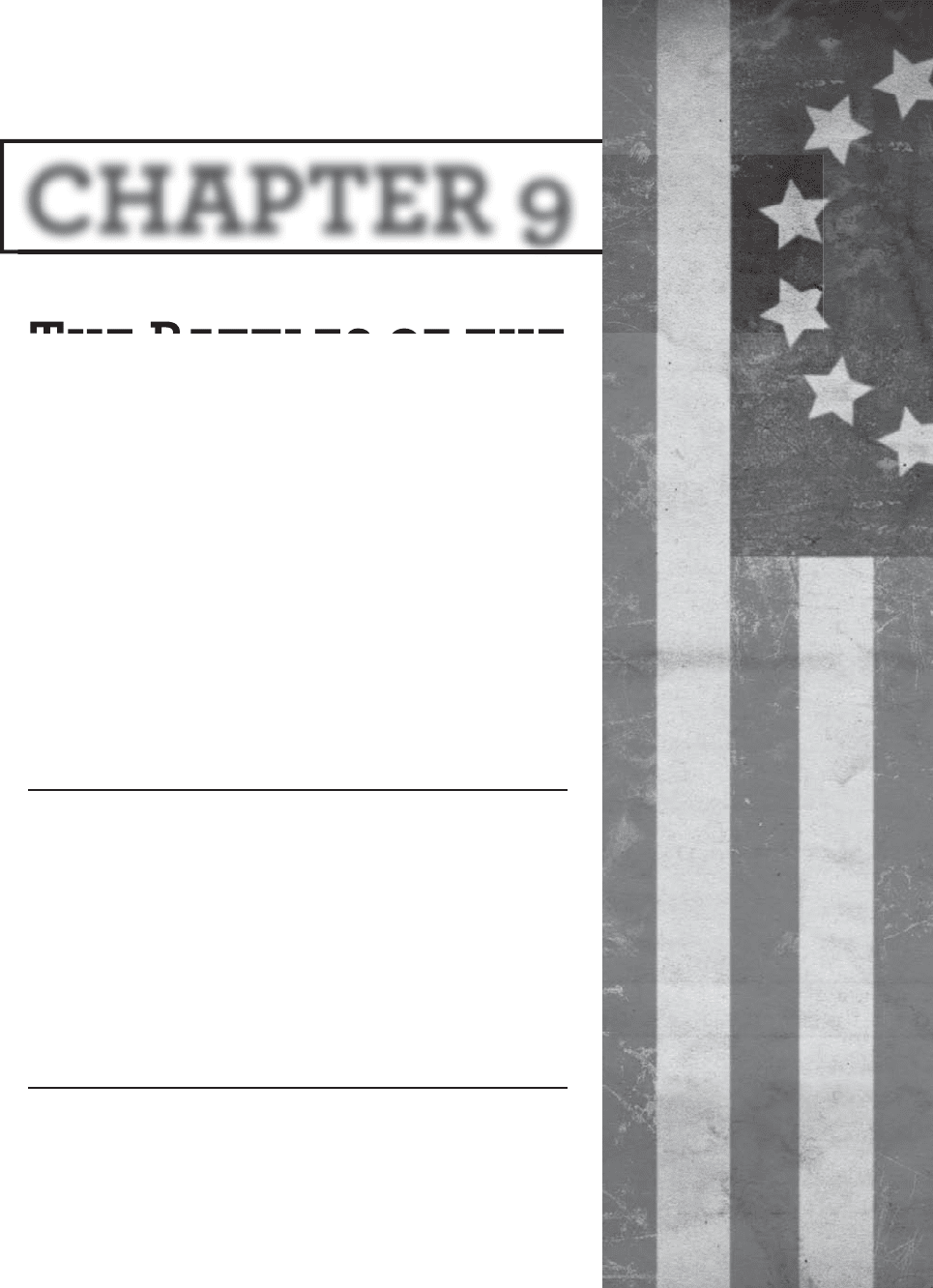
I
n many ways the course of the War of 1812 unfolded oddly.
Initially the British, distracted by their fi ght with Napoleonic
France, devoted few resources to fi ght in North America,
while the Americans began the confl ict with grandiose
visions of their own abilities, which were quickly belied by
incompetence on the battlefi eld. However, as the list of battles
below shows, over time the Americans showed an increased
ability to win battles. By the end of 1814, after notching sev-
eral major victories, the Americans had fought the British to
a draw despite the latter's clearly superior naval power.
BATTLE OF QuEENSTON hEIGhTS
On Oct. 13, 1812, Gen. Stephen Van Rensselaer, commanding
a force of about 3,100 U.S. militia, sent advance units across
the Niagara River. They established themselves on the steep
escarpment above Queenston (Queenstown) and at fi rst suc-
cessfully defended their position. The main body of U.S. troops,
however, refused to cross the river in support. The advance party
was then surrounded by the British, who captured 925 Ameri-
cans, thereby temporarily stopping a U.S. invasion into Canada.
BATTLE OF LAkE ERIE
On Sept. 10, 1813, Master Commandant Oliver Hazard Perry’s
fl eet of nine ships engaged six British warships under Capt.
The Battles of the
War of 1812
The Battles of the
ChAPTER 9
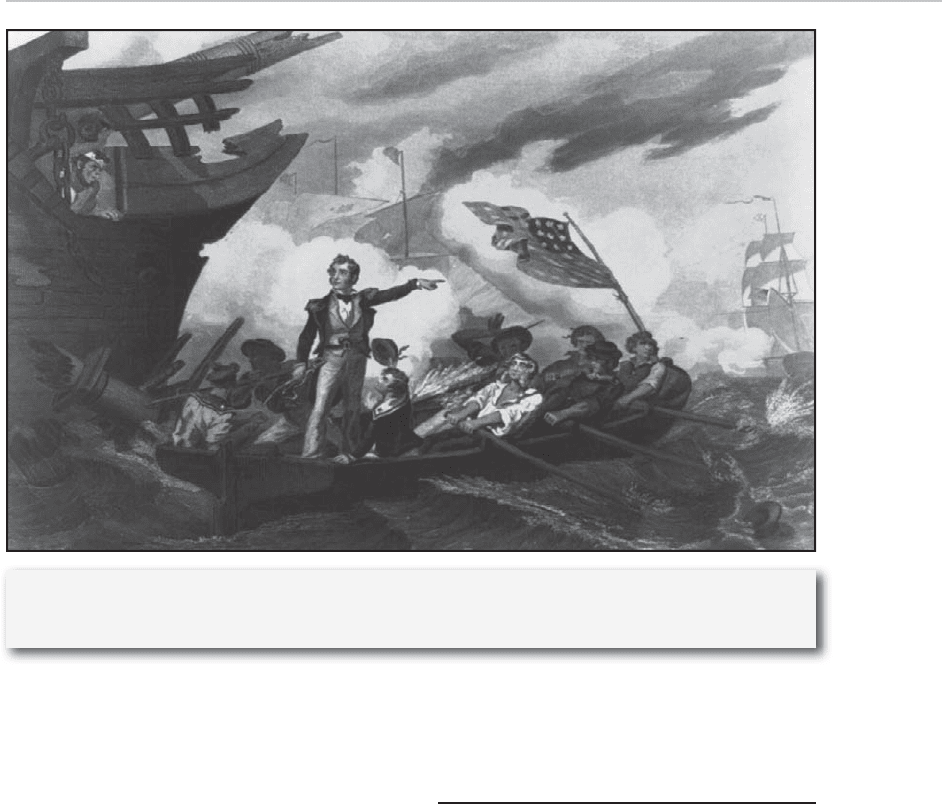
198 | The American Revolutionary War and the War of 1812: People, Politics, and Power
territorial cession in the Northwest to
Great Britain in the peace settlement.
BATTLE OF ThE ThAMES
Fought on Oct. 5, 1813, the Battle of the
Thames (also known as the Battle of
Moraviantown) was a decisive American
victory over British and Indian forces
in Ontario, Can., enabling the United
States to consolidate its control over the
Northwest.
After the U.S. naval triumph in the
Battle of Lake Erie in September 1813,
Robert Heriot Barclay in Lake Erie. After
Perry’s fl agship, Lawrence , had su ered
heavy casualties and had been reduced
to a defenseless wreck, he transferred to
a sister ship, the Niagara , and sailed
directly into the British line, fi ring broad-
sides and forcing its surrender. The
British lost 40 men, with 94 wounded; the
Americans, 27 killed and 96 wounded.
The destruction of the British squadron
on Lake Erie ensured American control
of the lake, reversed the course of the
Northwest campaign, and forced the Brit-
ish to abandon Detroit, precluding any
The heroic U.S. Admiral Oliver Hazard Perry in a rowboat on his way to the U.S. Brig Niagara
during the Battle of Lake Erie. Library of Congress Prints and Photographs Division

The Battles of the War of 1812 | 199
good defensive position in the woods
along the riverbank and, despite their
inferior numbers, managed to stop
Purdy’s advance. After this setback,
Hampton withdrew back across the border.
(At least 90 percent of the British troops
at Châteauguay were French Canadians.)
By forcing the Americans to abandon
their projected attack on Montreal, the
Battle of Châteauguay thus exerted a
decisive influence on U.S. strategy during
the 1813 campaign.
BATTLE OF CRySLER’S FARM
In October 1813 a U.S. force of more than
7,000 men set out in ships from Sackets
Harbor, N.Y., to attack Montreal. On
November 11, the Americans, encounter-
ing rapids on the St. Lawrence River at
the Long Sault, now in Ontario, disem-
barked on the Canadian shore at that
point. They divided into a main body,
under Gen. James Wilkinson, which
advanced toward Cornwall, and a rear
guard of approximately 1,600 troops
commanded by Gen. John Boyd. The
rear guard made contact with the British
force of about 600 troops under Col. J. W.
Morrison, and Wilkinson ordered Boyd
to attack.
The resulting action was fought on
farmlands beside the river. British casual-
ties numbered 200; American losses were
more than 400, including 100 taken pris-
oner. The battle ended with the withdrawal
of the Americans. Learning that another
U.S. force, under Gen. Wade Hampton,
the British commander at Detroit, Brig.
Gen. Henry A. Procter, found his posi-
tion untenable and began a hasty retreat
across the Ontario peninsula. He was
pursued by about 3,500 U.S. troops under
Gen. William Henry Harrison, who was
supported by the U.S. fleet in command
of Lake Erie. The forces met near
Moraviantown on the Thames River, a
few miles east of what is now Thamesville.
The British, with about 600 regulars and
1,000 Indian allies under Tecumseh, the
Shawnee intertribal leader, were greatly
outnumbered and quickly defeated.
Many British troops were captured and
Tecumseh was killed, destroying his
Indian alliance and breaking the Indian
power in the Ohio and Indiana territo-
ries. After this battle, most of the tribes
abandoned their association with the
British.
After destroying Moraviantown, a vil-
lage of Christian Indians, the U.S. troops
returned to Detroit. The U.S. victory
helped catapult Harrison into the national
limelight and eventually the presidency.
BATTLE OF ChâTEAuGuAy
In the autumn of 1813, an invading
American force of about 4,000 troops
under Gen. Wade Hampton marched
toward Montreal through the Châteauguay
River valley. An American advance party
of 1,500 under Col. Robert Purdy and
some 460 British troops under Col.
Charles de Salaberry met at Châteauguay
on October 26. The British had taken up a

200 | The American Revolutionary War and the War of 1812: People, Politics, and Power
established themselves at Queenston.
On the night of July 24–25, a British force
under Gen. Phineas Riall moved forward
to Lundy’s Lane. On the 25th he was
reinforced by troops from Kingston
under the British commander in chief,
Gen. Gordon Drummond. The U.S. troops
advanced, and the battle began at 6 pm.
For hours on end, each side hurled des-
perate charges against the other in the
dusk and darkness. The losses on both
sides were the heaviest in the entire war.
With fewer than 3,000 men, the British
had 878 casualties, 84 of whom were killed;
the Americans suered 853 casualties,
with 171 killed. Drummond, Riall, Brown,
and the American general Winfield Scott
were all severely wounded, and Riall was
taken prisoner.
By midnight, the U.S. troops, too
exhausted to attack again, fell back, leav-
ing Drummond’s men in possession of
the field. The British troops, in turn, were
too exhausted to pursue. Neither side
won a decisive victory, but the action
stopped the advance of the Americans,
who withdrew to Fort Erie the next day.
BATTLE OF PLATTSBuRGh
The Battle of Plattsburgh resulted in an
important American victory on Lake
Champlain that saved New York from
possible British invasion via the Hudson
River valley. A British army of some
14,000 troops under Sir George Prevost
reached Plattsburgh in a joint land and
sea operation. The American defenders
had been turned back at Châteauguay on
October 26, Wilkinson retreated across
the river to St. Regis, N.Y.
Crysler’s Farm Battlefield Memorial
Park was ocially opened in 1961.
BATTLE OF ChIPPEWA
At the beginning of July 1814, an
American army of more than 4,000 men
under Generals Jacob Brown and
Winfield Scott crossed the Niagara River
and took Fort Erie. The Americans
intended to push northward toward Lake
Ontario and on to Burlington and York
(modern Toronto). About 2,000 British
regulars and Canadian militia from Fort
George and along the lower Niagara,
under Gen. Phineas Riall, rushed south-
ward to stem the U.S. advance. On July 5
Riall launched an attack at Chippewa
upon the more numerous U.S. forces and
was badly beaten. British casualties
numbered 604; the Americans, 335.
Although the victory restored American
military prestige, it accomplished little
else, largely because the expected naval
support needed for a U.S. advance to the
north and west failed to materialize.
BATTLE OF LuNDy’S LANE
Fought on July 25, 1814, a mile west of
Niagara Falls, the Battle of Lundy’s Lane
ended a U.S. invasion of Canada. After
defeating the British in the Battle of
Chippewa on July 5, 1814, American
troops under Gen. Jacob Brown
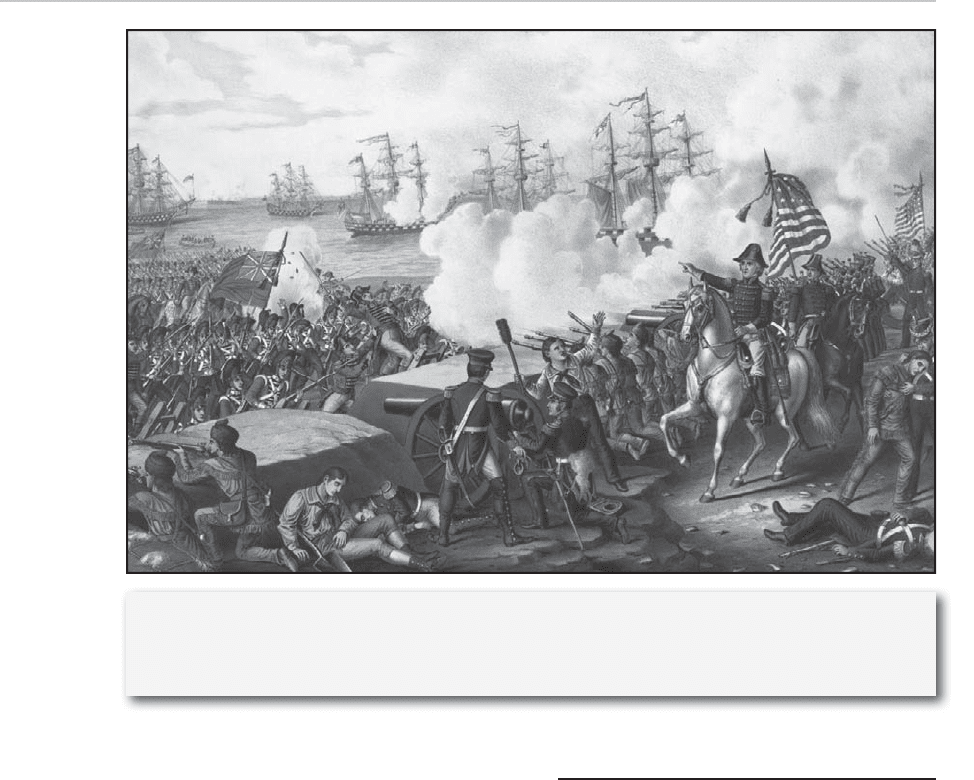
BATTLE OF NEW ORLEANS
In the autumn of 1814 a British fl eet of
more than 50 ships commanded by Gen.
Edward Pakenham sailed into the Gulf of
Mexico and prepared to attack New
Orleans, which is strategically located at
the mouth of the Mississippi River. On
December 1, Gen. Andrew Jackson , com-
mander of the U.S. Army of the Southwest,
hastened to the defense of the city.
Jackson’s army of between 6,000 and
included 1,500 regulars and about 2,500
militia commanded by Gen. Alexander
Macomb, supported by a 14-ship American
naval squadron under Commodore
Thomas Macdonough. The outcome of the
battle was determined on water when
the British fl eet was decisively defeated
on Sept. 11, 1814. Deprived of naval sup-
port, the invading army was forced to
retreat. The victory at Plattsburgh infl u-
enced the terms of peace drawn at the
Treaty of Ghent the following December.
Gen. Andrew Jackson (on the white horse) leading his troops in battle against Gen. Edward
Pakenham’s vanquished British troops in the Battle of New Orleans, Jan. 8, 1815. Library of
Congress Prints and Photographs Division
The Battles of the War of 1812 | 201

202 | The American Revolutionary War and the War of 1812: People, Politics, and Power
had fortified their position that the fight-
ing lasted only half an hour, ending in
a decisive U.S. victory and a British
withdrawal. British casualties numbered
more than 2,000 (289 killed); American,
only 71 (31 killed). News of the victory
reached Washington, D.C., at the same
time as that of the Treaty of Ghent and
did much to raise the low morale of the
capital. The Battle of New Orleans greatly
enhanced the reputation of Jackson as a
national hero.
7,000 troops consisted chiefly of militia-
men and volunteers from southern states.
Because of slow communications, news
of the peace treaty between Britain and
the United States that had been signed at
Ghent (Dec. 24, 1814) did not reach the
United States in time to avert the battle,
in which Jackson’s troops fought against
7,500 British regulars who stormed their
position on Jan. 8, 1815. So eective were
the earthworks and the barricades of
cotton bales with which the Americans
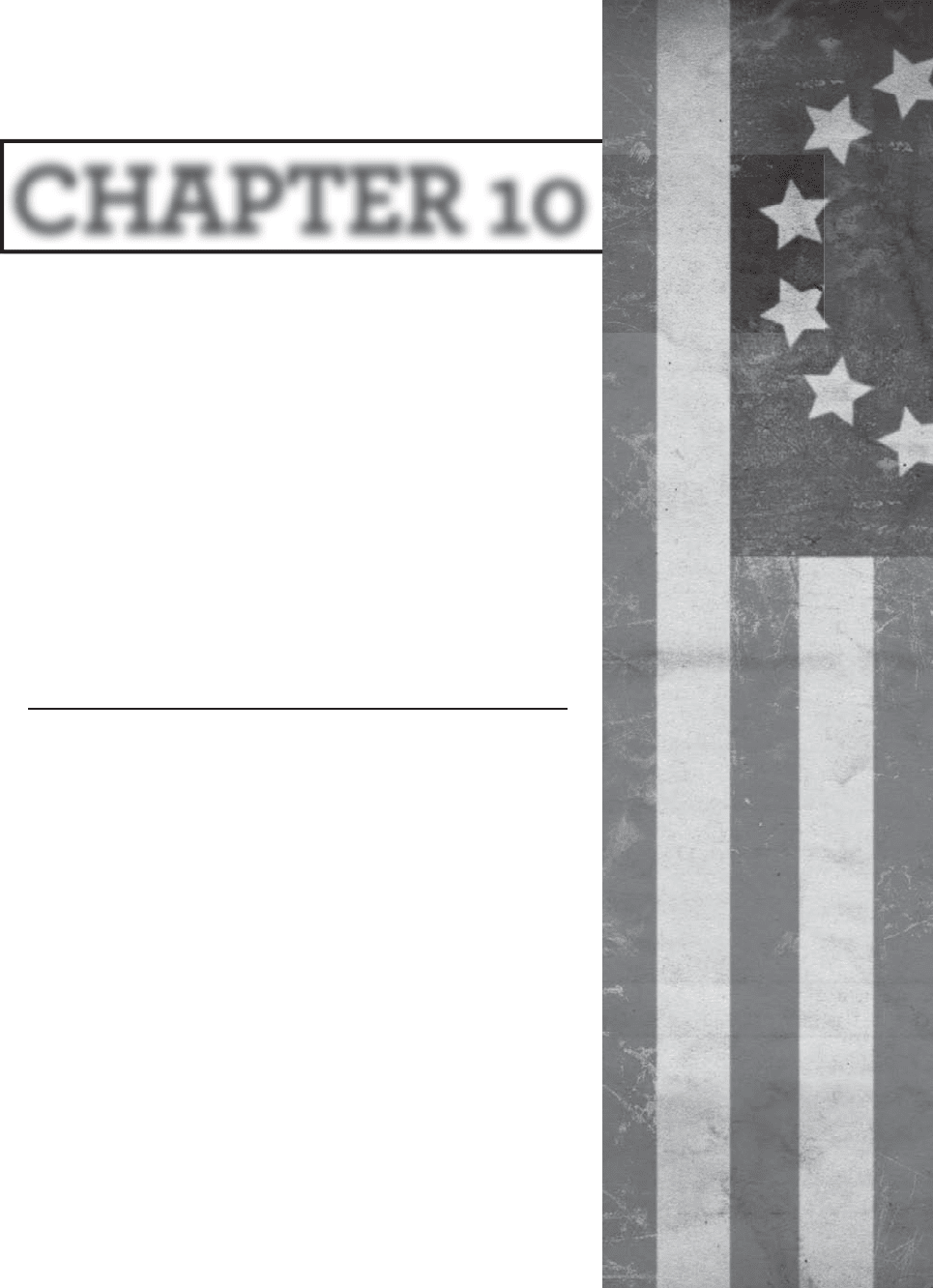
ChAPTER 10
D
on’t give up the ship,” said Capt. James Lawrence as
he lay dying during a sea battle near Boston. The
speaker of this much-quoted rallying cry was just one of the
important American military leaders of the War of 1812.
Others included a “fi ghting Quaker,” an infamous pirate, and
several future presidents who would infl uence events in the
United States long after the war was over.
ThE AMERICAN SIDE
William Bainbridge
(b. May 7, 1774, Princeton, N.J.—d. July 27, 1833,
Philadelphia, Pa.)
American naval o cer William Bainbridge distinguished
himself during the War of 1812 by capturing the British
frigate Java .
Bainbridge commanded merchant vessels from 1793 to
1798, when he became an o cer in the newly organized U.S.
Navy. He served in the war with the Barbary States (1801–05)
and was in command of the frigate Philadelphia when it was
captured by the Tripolitans (1803). Imprisoned for a time, he
returned to the merchant marine upon his release (1805). At
the outbreak of the War of 1812 he was again commissioned
in the U.S. Navy and was given command of the frigate
Constitution. His capture of the Java o the Brazilian coast
Military Figures
of the War of 1812
“
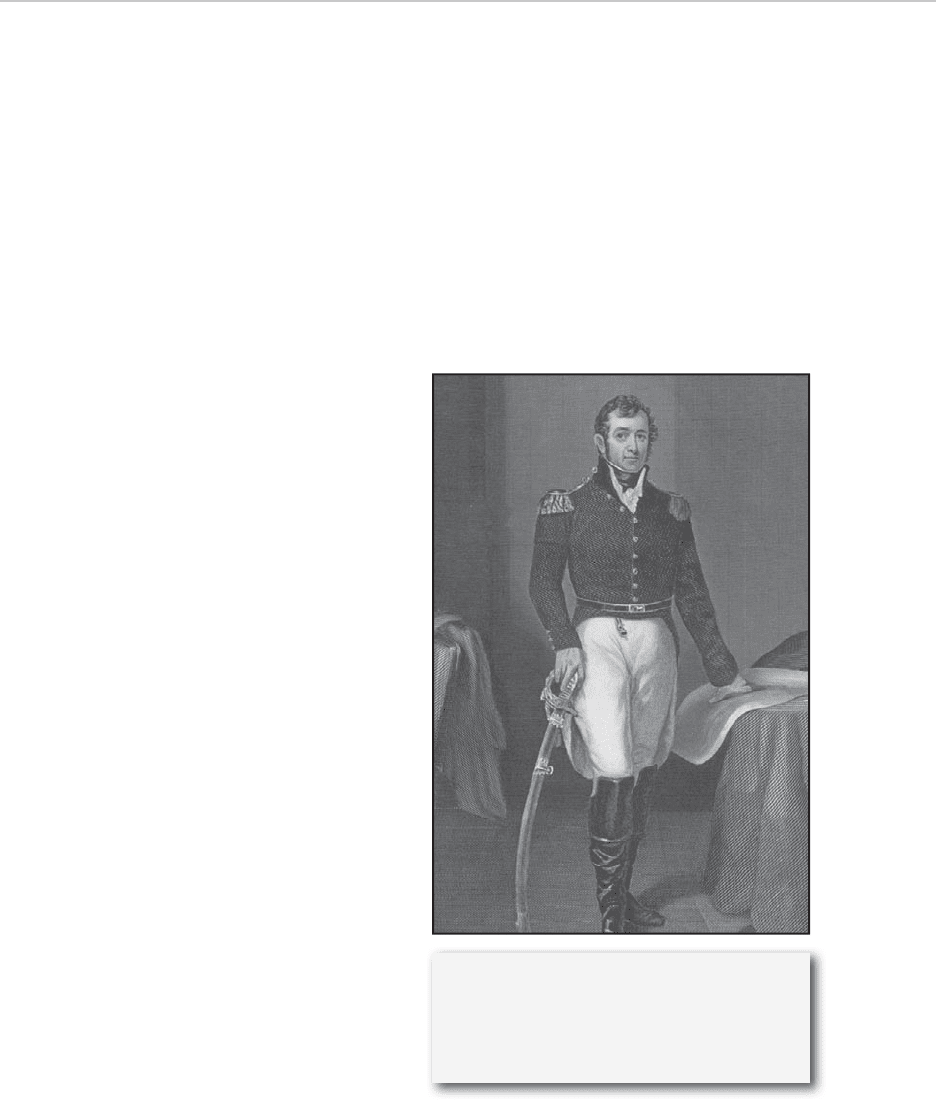
204 | The American Revolutionary War and the War of 1812: People, Politics, and Power
The Americans retreated to Fort Erie,
where they were besieged by the British.
Brown, resuming command, launched a
sortie on September 17 that destroyed so
much of the enemy artillery that the
British abandoned the siege a few days
later. Though the Americans were in no
shape to pursue, Brown’s hard fi ghting
solidifi ed his position as a national hero: a
fi ghting Quaker and the ideal model of a
citizen soldier. As the army’s senior rank-
ing o cer, he became its commanding
was one of the notable American naval
victories of the war and, according to some,
helped his ship earn the sobriquet “Old
Ironsides.”
Jacob Jennings Brown
(b. May 9, 1775, Bucks County, Pa.—
d. Feb. 24, 1828, Washington, D.C.)
American Gen. Jacob Jennings Brown
made his mark in the War of 1812 as “the
fi ghting Quaker.”
Of Pennsylvania Quaker heritage
and upbringing, Brown established him-
self as a prominent New York citizen and
rose to brigadier general in the state
militia before the War of 1812. His suc-
cessful defense of Sackets Harbor, N.Y.,
on May 29, 1813, brought him national
recognition and a general’s commission
in the regular army. He commanded a
brigade under Gen. James Wilkinson in
the abortive campaign against Montreal,
and he succeeded to the command of the
Army of the North in January 1814.
After supervising the further train-
ing of his still-raw troops, Brown crossed
the Niagara River on July 3, 1814. On
July 5, he defeated a British force under
Gen. Phineas Riall at the Battle of
Chippewa , but expected naval support
failed to appear and the British brought
up reserves. Threatened with being cut
o from his base at Fort Erie, on July 25
Brown engaged a slightly larger British
force at the Battle of Lundy’s Lane . A long
day of fi erce fi ghting ended in a draw,
with Brown badly wounded.
Gen. Jacob Jennings Brown. Engraving
created from the original painting by
Alonzo Chappel. Hulton Archive/
Getty Images
